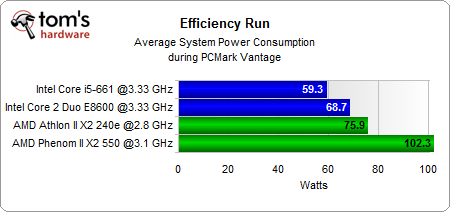Clarkdale's Efficiency: Core i5-661 Versus Core 2, Athlon II, And Phenom II
Efficiency Results
Our efficiency run consists of several applications written into a batch script in the following order:
- 3ds Max
- DivX
- Xvid
- Lame
- MainConcept
- PDF Creation
- Photoshop
- AVG Anti Virus
- WinRAR
- WinZip
Some of these applications don’t take advantage of multiple processing cores; others do heavily. The batch file creates time stamps at the beginning of the run and once it has finished. This way we track the total time required for the test run to complete.
In the meantime, we also track power consumption in one-second intervals during the test run. This allows us to examine power consumption for each application and to create power consumption profiles for each system. The result is runtime performance score and power consumption readings, which we use to analyze efficiency. Idle power is taken out of the equation since differences are rather small.
The runtime reflects total performance of the test system and reveals benefits for the Core i5-661 in the same range as we’ve seen in individual benchmark runs.
The average power used during our efficiency workload was lowest on the new Core i5…
…as well as the total power used to complete the workloads. This is where the new Intel platform strikes hardest. If we now go ahead and relate performance to watt-hours used…
… we get a score that says that Intel’s new Core i5-661 delivers 43% more performance per watt than a Core 2 Duo machine with the G45 chipset and twice the efficiency as an Athlon II X2 240e on AMD’s 785G. Clearly, more performance combined with reduced power consumption results in a pretty heavy efficiency dominance.
Get Tom's Hardware's best news and in-depth reviews, straight to your inbox.
Our workload does not include any idle time, which some might criticize. However, in this case, the extremely low idle power of the Core i5-661 system would move the results even more in its favor, as it requires significantly less power.




